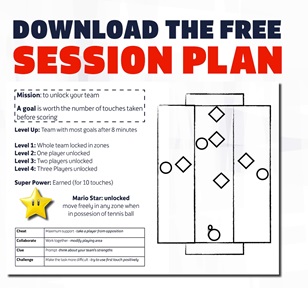
Unlocking The Potential Of A Games Generation
People are investing their time (and money) into playing video games, so what is it about gaming that captivates the human mind so successfully?
Recent work on the Foundation Phase FA England DNA recognises the digital lives of kids today and that coaches are working with a games generation. How will coaches learn from video game design to help today’s young children to fall in love with sport, and football?
So, how can football coaches use video game design to inspire practice design?
No topic or learning focus
Good game design uses 'mission based learning' where there is no learning outcome or learning focus. What the player plays and practices is dependent on how they interact with the game.
Consequently, the ways in which the player responds to the mission will be different for each player and their teams. We don’t play Mario Brothers and say to ourselves, “today I’m practicing how to jump!”
How will the mission you set for your players allow them to decide what to practice and learn in the game? Rather than focusing on technical components (passing, pressing), try to design a mission that will involve the game as a whole? For example, "your mission is to unlock your team from zones" rather than "today we are focusing on in possession, staying on the ball.”
Players decide when & how they’d like support
Good game design doesn't automatically pause when the game player makes a mistake, or needs to be challenged - it is down to the player to decide when and how they'd like support.
Placing onus on players to pause the game develops their in-action game skills, such as, “I need help with this” or “we need to alter how we do this”. These meta-cognitive opportunities help players to become good learners where they're able to learn the game independently. After all, isn’t that what we ask the players to do on match days?
Have a look at how the 4 C Model has been used in the example session plan. This model may help you to consider ways in which players can opt to pause and reflect on what they need help with. Will individual players and teams have the opportunity to pause the game whenever they like? Or will you structure the timing of the pauses?
Players earn the opportunity to power up!
In video games, power ups or super powers are always earned and not given. Remember in the classic video game Sonic the Hedgehog, where there was the chance to earn Sonic Fast Feet? How will your players earn a super power in the game? Don't forget that super powers are temporary. How long will your players have a power for? Sometimes using a specific number of seconds, or number of touches is a useful way to time a superpower.
Progress is measured using level-ups
What will the players in your game need to do, in order to get to the next level? We tend to plan for 'progressions' in our practices to enhance complexity of the practice for our players. Or, we might decide to set challenges to alter the difficulty of the task. How do we know the 'right time' to use progressions or challenges?
In Good Game Design, assessment is explicitly woven into design, resulting players 'leveling up' once they can apply a problem solution. In the example session plan, a scoring system is used to measure when a team is ready to level up. The next level is slightly more difficult than the one before, but requires similar skills and strategies.
Players can save their progress for next session....
Good game design uses a ‘risk alleviating design’ where players are able to make mistakes and understand that mistakes are part of learning. In video games, making a mistake helps you to understand what to do next, and players understand their progress will not be diminished if a mistake is made.
As coaches or teachers, how often do we design practices where players can keep track of their progress (as a team, and as individuals), and practice the same game multiple times?
Providing players with the chance to master a game vs. designing a new game every week for our players. Consider how your game design allows players to feel ‘risk alleviated’ where their progress can be saved.
This article was written by FA Tutor, and Surrey coach, Amy Price - follow her on Twitter.










